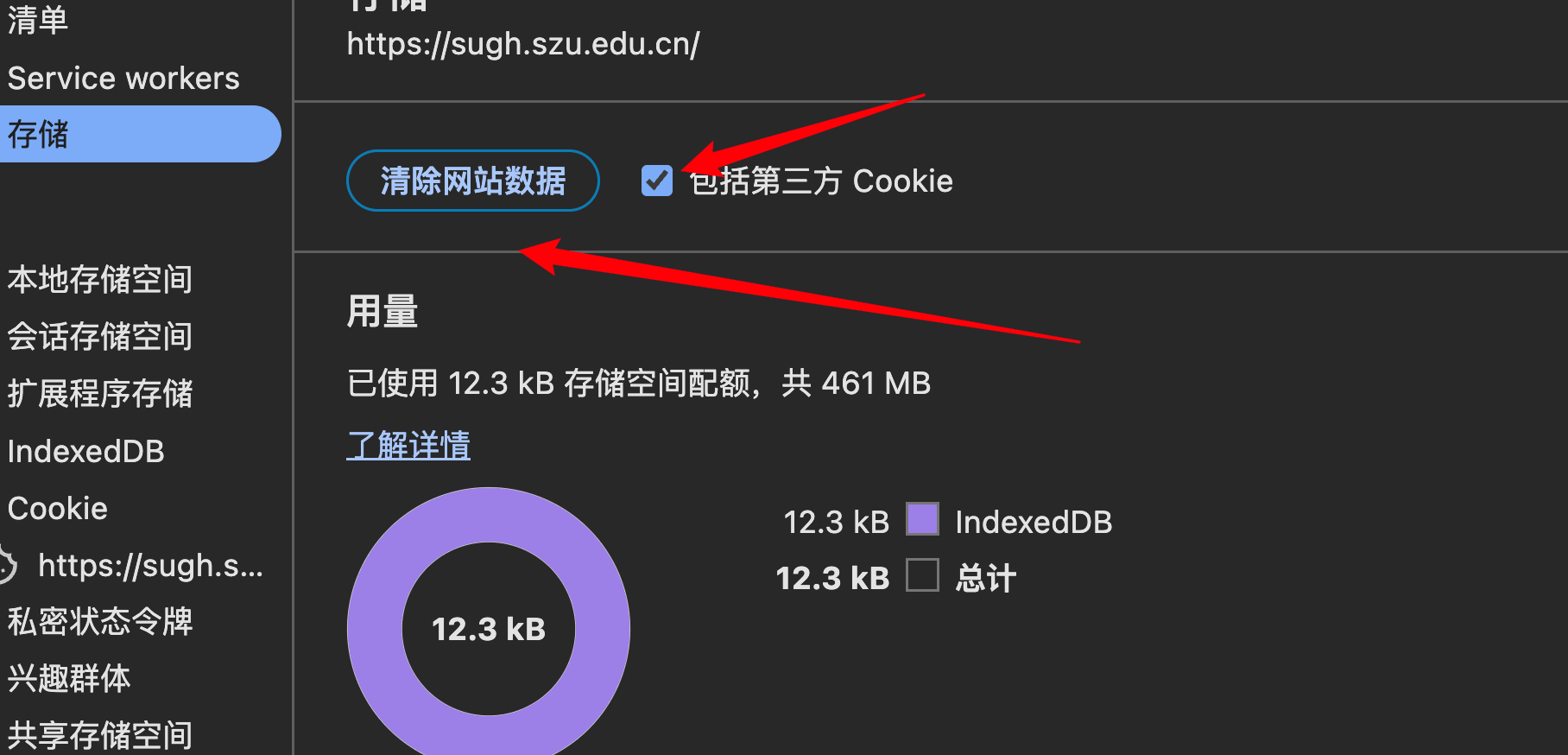网址:aHR0cHM6Ly9zdWdoLnN6dS5lZHUuY24vSHRtbC9OZXdzL01haW4vMTAyLmh0bWw=
一、开始流程
网页进去之后,直接点击检查,然后就会发现无限debugger,这个不用管就行了,找到应用清空数据还有cookie

然后点击找到事件监听器,点击脚本刷新页面,就会看到,这个看到这个ts文件,这是瑞数的基本流程,做过瑞数六之前的都知道主要的就是三个文件,一个ts文件,一个启动文件,一个content
找到这三个文件保存到不同的文件中,写上这个
javascript
require('./ts.js');
require('./tsload.js');
function get_cookie(){
console.log(document.cookie)
return document.cookie;
}
get_cookie()然后加上代理
javascript
//////////////////////////
let setProxyArr = function (proxyObjArr) {
for (let i = 0; i < proxyObjArr.length; i++) {
const handler = `{
get:function(target,property,receiver){
console.log("方法:","get","对象","${proxyObjArr[i]}","属性:",
property,"属性类型:",typeof property,"属性值:",target[property],"属性值类型:",typeof target[property]);
return Reflect.get(...arguments)
},
set:function(target,property,value,receiver){
console.log("方法:","set","对象:","${proxyObjArr[i]}","属性:",
property,"属性类型:",typeof property,"属性值:",value,"属性值类型:",typeof target[property]);
return Reflect.set(...arguments);
}
}`;
eval(`try{
${proxyObjArr[i]};
${proxyObjArr[i]} = new Proxy(${proxyObjArr[i]},${handler});
} catch (e){
${proxyObjArr[i]} = {};
${proxyObjArr[i]} = new Proxy(${proxyObjArr[i]},${handler});
}`);
}
}
function watch(object) {
const handler = {
get: function (target, property, receiver) {
if (property !== 'isNaN' && property !== 'encodeURI' && property !== "Uint8Array" && property !== 'undefined' && property !== 'JSON') {
console.log("方法:", "get", "对象", target, "属性:",
property, "属性类型:", typeof property, "属性值:", target[property], "属性值类型:", typeof target[property]);
}
return Reflect.get(...arguments)
},
set: function (target, property, value, receiver) {
console.log("方法:", "set", "对象:", target, "属性:",
property, "属性类型:", typeof property, "属性值:", value, "属性值类型:", typeof target[property]);
return Reflect.set(...arguments);
}
}
return new Proxy(object, handler)
}
const safeFunction = function safeFunction(func) {
//处理安全函数
Function.prototype.$call = Function.prototype.call;
const $toString = Function.toString;
const myFunction_toString_symbol = Symbol('('.concat('', ')'));
const myToString = function myToString() {
return typeof this === 'function' && this[myFunction_toString_symbol] || $toString.$call(this);
}
const set_native = function set_native(func, key, value) {
Object.defineProperty(func, key, {
"enumerable": false,
"configurable": true,
"writable": true,
"value": value
});
}
delete Function.prototype['toString'];
set_native(Function.prototype, "toString", myToString);
set_native(Function.prototype.toString, myFunction_toString_symbol, "function toString() { [native code] }");
const safe_Function = function safe_Function(func) {
set_native(func, myFunction_toString_symbol, "function" + (func.name ? " " + func.name : "") + "() { [native code] }");
}
return safe_Function(func)
}
//创建函数
const makeFunction = function makeFunction(name) {
// 使用 Function 保留函数名
let func = new Function("v_log", `
return function ${name}() {
v_log('函数${name}传参-->', arguments);
};
`)(v_log); // 传递 v_log 到动态函数
safeFunction(func);
func.prototype = myProxy(func.prototype, `方法${name}.prototype`);
return func;
}
window = global
window.Buffer = Buffer
window.Window = function Window() {
}
Object.setPrototypeOf(window, window.Window.prototype)
window.Document = function Document() {
}
delete global
delete Buffer
delete __dirname
delete __filename
delete process
safeFunction(window.Window)
safeFunction(window.Document)
function HTMLDocument() {
}
Object.setPrototypeOf(HTMLDocument.prototype, window.Document.prototype)
HTMLDocument.prototype.constructor = HTMLDocument
document = new HTMLDocument()
window.HTMLDocument = HTMLDocument
safeFunction(window.HTMLDocument)
function Navigator() {
}
navigator = new Navigator()
window.Navigator = Navigator
safeFunction(window.Navigator)
function Screen() {
}
screen = new Screen()
window.Screen = Screen
safeFunction(window.Screen)
function History() {
}
history = new History()
window.History = History
safeFunction(window.History)
function Location() {
}
location = new Location()
window.Location = Location
safeFunction(window.Location)
setProxyArr(['window', 'document', 'location', 'history', 'screen', 'navigator'])二、然后运行进行补环境,我这里就说一下其中补环境的重点吧
window中需要补的环境基本上也没什么
javascript
window = global;
window.Buffer = Buffer
window.top = window
window.self = window
window.window = window
window.setInterval = function setInterval() {}
window.clearInterval = function clearInterval() {}
window.setTimeout = function setTimeout() {}
还有一些函数直接补到window上就行了,其中
window.MutationObserver = function MutationObserver() {
// console.log("MutationObserver", arguments)
}
window.MutationObserver.prototype.observe = function observe(arg) {
// console.log("MutationObserver.observe", arguments)
}
这个注意一下,有的网站需要有的不需要,加上可能进入一个无限循环,
其他的就是一些基本的参数了document中
javascript
createELement中检测了div、a、form、input标签
getElementById中返回了一个meta标签
getElementsByTagName中检测了base、script、Meta标签
其中最重要的就是script和Meta标签,最重要的就是这两个
其中script中检测了innerText、src、getAttribute(r="m")、parentElement(removeChild)
meta中getAttribute、parentNode(removeChild)、contentlocation、history、localStorage、sessionStorage这些没有什么好补环境的,重要的还是里面的一些toString()检测,还有原型链检测

请求文件
python
import requests
import execjs
from lxml import etree
session = requests.session()
# 打开补环境文件
with open("env.js", "r", encoding="utf-8") as f:
js_code = f.read()
# 第一次请求
headers = {}
response = session.get("https:", headers=headers)
cookie = [*response.cookies][0]
cookies = {
cookie.name: cookie.value
}
# 第一次请求获取的cookie1
# print(cookie)
# print(response.text)
html = etree.HTML(response.text)
# 获取ts文件
ts = html.xpath('//script')[0].text
# 获取tsload的文件链接,请求获取内容
tsload_url = 'https:\' + html.xpath('//script')[1].attrib['src']
tsload = session.get(tsload_url, headers=headers).text
# 获取content内容
content = html.xpath('//meta')[1].attrib['content']
print("content内容:", content)
# 替换环境文件中的内容
js_code = js_code.replace('ts文件', ts).replace('tsload文件', tsload).replace('content文件', content)
# 保存到新的文件中
with open("now.js", "w", encoding="utf-8") as f:
f.write(js_code)
print("保存成功")
# 获取cookie2
cookie2 = execjs.compile(js_code).call('get_cookie')
name, value = cookie2.split('; path')[0].split('=', 1)
cookies[name] = value
# 输出最后的cookie
print(cookies)
response = session.get("https:", headers=headers, cookies=cookies)
print(response.text)
print(response)
最后也是成功结束了🥰
